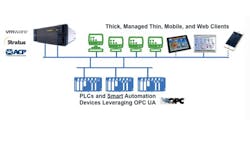With so many technologies and trends converging to create the industrial automation space of the future, it seems that more companies are popping up daily—not only to take advantage of the hype surrounding the Industrial Internet of Things (IIoT), but also to help figure out how to deal with all the complexity.
Stratus Technologies aims to ensure data integrity that’s needed for successful IIoT implementation, and also tackle the complex relationship between IT and OT. The Stratus Always-On Infrastructure for IIoT combines the company’s ftServer technology with VMware vSphere 6.0, plus application monitoring and OPC integration.
Unlike many of the new names we’re hearing in the IIoT space, Stratus is a company that has actually been around a while—for about 35 years. Stratus made its mark offering fault-tolerant and redundant hardware, particularly embedded in the financial services and telecom markets. The company has been working on its industrial game for more than a decade now, and in the past few years has been building out partnerships with automation suppliers like Rockwell Automation and Schneider Electric, said Jason Andersen, Stratus’ vice president of business line management.
Now it’s finally time to make a little noise about the product lines it’s been building around manufacturing and energy industries, going to market with what Andersen said is more of a solution-style play to define what a resilient infrastructure looks like for the industrial automation world.
Part of what that means is a system that is, at its core, fully redundant. In working with partners like Rockwell Automation, Stratus’ system is most often deployed on SCADA systems and historians, which are going through a transformation in importance, Andersen said, as data collection becomes a more vital aspect of production. The ftServer plugs into the manufacturing environment—whether a shop floor or offshore oil rig—and immediately fails over if any component in the system fails.
“As SCADA and sensor systems increase in complexity and their data rates move to millisecond intervals, the need for reliability and availability increases even more,” Andersen said.
Another key aspect of the technology is the operationally simple platform. With continued adoption of virtualization by IT, Stratus has reduced complexity for OT customers by integrating the ftServer platform with VMware.
“More and more people are asking for that,” Andersen said. “By and large our biggest fan is the operational technology person. Our partners spend a lot of their time with OT folks, and we’re trying to help them bridge the gap with IT.”
By consolidating traditionally disparate systems, ftServer Gen8 for VMware streamlines the management of different devices, such as servers, management consoles and external storage, into a single solution for industrial automation teams with limited IT resources.
The OPC server enables ftServer to be plugged into an operational environment, where OT personnel are able to see and monitor the server, Andersen said, noting that the integration of Sightline Assure “allows the IT guys to see in a very detailed way what’s going on. They can monitor the performance of the applications, as well as the hardware underneath, and get very granular visibility of what’s going on.”
Stratus delivers these solutions primarily through its automation partners for the industrial space, where demand has increased for redundancy and simplicity as manufacturers upgrade their systems to prepare for IIoT. “It’s been very pronounced in the last few years,” Andersen said. “There’s a heavy compliance and regulatory component to it, so the areas where we’re strongest are areas where they absolutely need to not lose any data, like in food or energy.”
Leaders relevant to this article:

